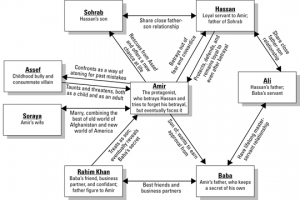Analyse how language features were used to capture the reader’s imagination.
- Amir’s narrative point of view
- Foreshadowing
- First Language Words, Festival, and cultural references
- Symbolism- kites, lamb to the slaughter, the cleft palate
In this novel, The Kite Runner written by Khaled Hosseini uses numerous effective language features such as foreshadowing, and symbolism to help develop the main character, Amir. This character then goes on to help the reader understand the themes of the book betrayal and redemption. The author uses symbolism to represent
Thorugh out the novel, the author uses the language technique narrative point of view to tell the
PARAGRAPH ONE: Narrative point of view- first person. Amir talks about cultural, religious, political, social events and issues.
PARAGRAPH TWO: Foreshadowing- hints at events to come
PARAGRAPH THREE: Symbolism and themes- Kites, Cleft lip, family relationships, guilt, redemption,
CONCLUSION:
Discuss how the author uses language techniques to develop a main character in the novel, and how this character helps you understand one or more themes/ideas.
LANGUAGE TECHNIQUE:
- Foreshadowing
- Symbolism
Foreshadowing:
it helps Develop Amir because from the glimpses that we got from the beginning of the book because the write foreshadows that Amir will later on become guilty for not helping Hassan.
As well as hinting that Mair’s life is going to change forever and that he is not as good as he may seem, but still buys into the society buy betraying Hassan since he is his servant.
Symbolism:
On the Day of the kite fishing Hassan had a dream about a monster being in a lake, Amir walk into the lake and Hassan follows, Hassan then goes onto say “Don’t worry there is not a monster waiting for you in the streets of Kabul”. This symbolises Assef as he is the one that raped Hassan, Hassan says that there isn’t a monster waiting for Amir because its instead waiting for him, (Assesf) Like in the dream when Hassan followed Amir into the lake the lake is just like the alleyway but this time Amir doesn’t have the same loyalty for Hassan so, therefore, doesn’t stand up to Assef to help his friend and doesn’t follow Hassan into the ‘lake’. The symbols of Hassan dream helps the reader understand what kind of friend Amir is to Hassan.
Kite running is another symbol that is used throughout the novel At the beginning of the novel the Amir and Hassan first enter the kite fighting competition it all seems very innocent and fun to both of them, But later on, kites become that constant reminder for Amir on how his betrayal that day in the alley. The kites are also a symbol for Amir to get his father to love him, and make Baba proud of him. At the end of the novel, after Hassan dies and his son becomes an orphan, Amir adopts him and takes him outside to do kite flying. At this point, Amir feels like he has redeemed himself because he couldn’t talk to Hassan and apologies to him instead he did the activity Amir and his best friend once loved with his nephew. Therefore the kites are also a symbol for redemption throughout the novel, as they go through Amir journey of how innocent they both were at the start, how he lost Hassan and become filled with guilt, then at the end when Hassan is going and Amir has once and for all redeemed himself.
The actual Kite its self-symbolizes Amirs life, the
Amir helping reader understands theme:
- Redemption
- Betrayal
